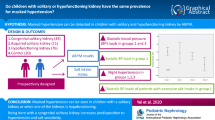Abstract.
The outcome of acute renal failure due to diarrhea-associated hemolytic uremic syndrome (D+ HUS) is generally predicted to be good. However, there are only a few long-term observations with detailed reports on long-term sequelae. Specifically, adequate long- term blood pressure (BP) evaluations are scarce. The present study evaluated BP in pediatric patients after childhood D+ HUS. The study group comprised 28 patients (20 males) aged 6–23.5 years (median 10.1 years). All patients had a history of D+ HUS at a median age of 1.1 years (range 0.5–6 years). Based on the duration of oliguria and/or anuria, the primary disease was classified as mild (n=6), moderate (n=6), or severe (n=16). The BP in these patients was studied at a median time of 8.4 years (range 2.3–22.9 years) after manifestation of D+ HUS by means of office BP measurements and 24-h ambulatory BP monitoring (ABPM) using a Spacelabs 90207 oscillometric monitor. Measurements were compared with normal values of published standards for healthy children and adolescents. Conventional office BP measurements were above the 95th percentile in 1 patient. By ABPM, 2 patients were diagnosed to have mean systolic daytime and nighttime values in the hypertensive range, and systolic and diastolic hypertension was confirmed in the first patient. All these patients had a severe form of D+ HUS in the past. By applying ABPM, BP anomalies were detected in 5 additional patients. Elevated systolic BP loads were found in 4 patients, and daytime systolic and diastolic hypertension in the other 1. At the time of the study, 2 of them were classified as ”recovered.” The late outcome of D+ HUS may be worse than anticipated. BP anomalies as long-term sequelae of D+ HUS could be identified by ABPM but not by office BP measurements. These findings may repre- sent an isolated sign of residual renal disturbance.
Similar content being viewed by others
Author information
Authors and Affiliations
Additional information
Received: 5 January 2001 / Revised: 4 June 2001 / Accepted: 6 June 2001
Rights and permissions
About this article
Cite this article
Krmar, R., Ferraris, J., Ramirez, J. et al. Ambulatory blood pressure monitoring after recovery from hemolytic uremic syndrome. Pediatr Nephrol 16, 812–816 (2001). https://doi.org/10.1007/s004670100679
Issue Date:
DOI: https://doi.org/10.1007/s004670100679




